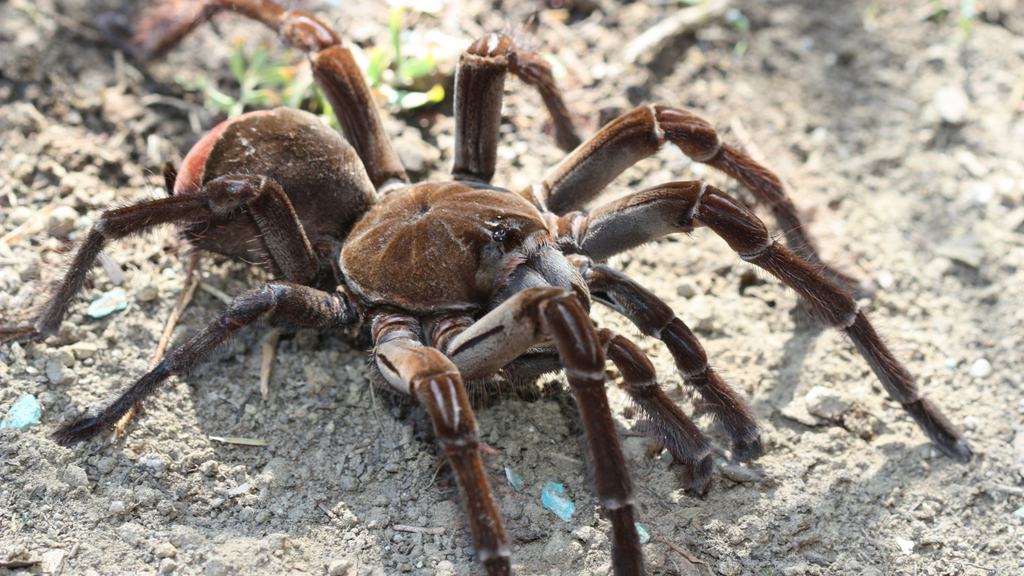The Differences Between Spiders and Tarantulas

What is a Tarantula?
Tarantulas are some of the most fascinating creatures in the spider world, but they often get a bad reputation due to their intimidating appearance. Before diving into all the cool stuff about tarantulas, let's break down exactly what they are.
The Merriam-Webster dictionary defines a tarantula as:
Tarantula (noun)
\ tə-ˈran-chə-lə, -tə-lə; -ˈranch-lə, -ˈrant- \
Plural: tarantulas also tarantulae \ tə-ˈran-chə-ˌlē, -tə-ˌlē ; -ˈranch-ˌlē, -ˈrant- \
1: Any of various large, typically ground-dwelling, hairy, mygalomorph spiders (family Theraphosidae) of warm regions that possess venomous fangs used to subdue and kill prey (such as insects, centipedes, frogs, and mice) caught by ambush or chase and that construct silk-lined burrows but do not build webs to trap food.
Now, if that sounds a little intimidating, don’t worry. While these spiders are indeed large, hairy, and can be pretty fearsome-looking, most tarantulas are harmless to humans and generally prefer to avoid confrontation. Instead of attacking, they usually run and hide, keeping to their burrows or hiding spots.
The Name "Tarantula" – A Fun Fact
You might be surprised to learn that the name "tarantula" actually doesn't come from the true tarantula at all. The name originally referred to a different spider, Lycosa tarantula, known today as the tarantula wolf spider. This species hails from the Italian town of Taranto, where it was believed that its bite caused a disease called "tarantism." People thought this bite would cause hysterical behaviors like uncontrollable dancing (hence, the tarantella dance). Modern science has debunked that myth, but the name stuck, and it ended up being applied to many other ground-dwelling spiders, including the ones we now call "true tarantulas."
What Makes a True Tarantula?
So, what sets tarantulas apart from the rest of the spider world? Well, all tarantulas are spiders, but not all spiders are tarantulas. There are over 40,000 species of spiders, which are part of the arachnid class. Arachnids include scorpions, ticks, mites, and, of course, spiders.
Tarantulas fall into a specific suborder called Mygalomorphae within the arachnids, which includes a group of spiders with some very distinctive traits. While all spiders have two main body parts (the cephalothorax and abdomen), tarantulas are part of a more ancient group of spiders with very specific features:
-
Fangs: Mygalomorphs like tarantulas have large, downward-facing fangs (orthognath) that they use to capture and subdue their prey.
-
Silk Production: Unlike more advanced spiders, tarantulas primarily use their silk for constructing burrows and hides rather than for trapping prey. However, their webs do help them detect nearby movement.
-
Diet: Tarantulas are opportunistic hunters. In the wild, they mostly hunt insects, but some of the larger species are known to tackle small reptiles, amphibians, and even small mammals when the chance arises. They may occasionally eat small birds, but this is rare.
In contrast, other spiders in the Araneomorphae suborder, such as orb-weavers and jumping spiders, have evolved more advanced silk production and rely on webs to capture prey. These spiders also have sideways-moving fangs (labidognath), unlike the more primitive downward-facing fangs of tarantulas.
Tarantula Lifespan & Reproduction
One of the most remarkable things about tarantulas is their lifespan. While most spiders live just a year or two, tarantulas can live anywhere from 20 to 30 years—though males tend to live shorter lives, often only about a third of the lifespan of females.
Tarantula reproduction is an intriguing process. The male will construct a "sperm web," deposit sperm on it, and then use his pedipalps (those specialized legs near the mouth) to collect the sperm. He then travels in search of a female. Once he finds her, the two will engage in a mating ritual, which can involve drumming or quivering to show the male’s worth. After mating, the male usually retreats quickly to avoid being eaten (though this doesn’t always work out in his favor).
The female lays her eggs in a protective silk egg sac, which she keeps safe in her burrow. The eggs hatch into small, immobile spiderlings that will need a few weeks to darken and molt into their first instar stage.
5 Key Differences Between Spiders and Tarantulas
There are a few defining differences between tarantulas and other spiders that are worth mentioning:
-
Size: Tarantulas are typically much larger than most spiders, and they are often covered in long, fine hairs called setae.
-
Diet: Unlike some spiders that eat plant material or nectar, tarantulas are strictly carnivorous and eat insects, small mammals, and occasionally reptiles or birds (though that’s rare).
-
Spinnerets: While most spiders have six spinnerets, tarantulas usually have only two or four. These spinnerets help them produce silk, but instead of using it to trap prey, they use it primarily for burrow construction and creating "trip lines" for detecting movement nearby.
-
Urticating Hairs: One of the unique features of many New World tarantulas is their ability to kick urticating hairs from their abdomen as a defense mechanism. These hairs are irritating to the skin and eyes of potential predators.
-
Lifespan: While most spiders live relatively short lives, tarantulas have impressive lifespans, often reaching 20 to 30 years in captivity. This slow growth means tarantulas take much longer to mature from spiderling to adult compared to smaller spiders.
Why Are Tarantulas Popular as Pets?
Tarantulas have become increasingly popular as pets in recent years, and it's easy to see why. They are relatively low-maintenance, docile, and come in a variety of beautiful colors and patterns. While they may look intimidating, they are quite calm and would rather run and hide than attack.
Additionally, many species of tarantula are now being bred in captivity, which helps protect wild populations. In the wild, habitats are being destroyed by farming, logging, and urbanization, which threatens the survival of many species. The rise of responsible pet keeping, along with regulations against the illegal capture and trade of wild tarantulas, has given hope to these species, and many are now thriving in captivity.
Ethical Considerations
It's important to always ensure that any tarantula you acquire as a pet is ethically sourced. The illegal pet trade remains an issue in many parts of the world, and it’s crucial to support legal, captive breeding efforts rather than contributing to the smuggling of wild tarantulas. Always look for reputable breeders and make sure the species you’re buying is ethically and legally bred.
Tarantulas might be intimidating to some at first glance, but they are truly fascinating creatures with unique behaviors, long lifespans, and docile temperaments. If you're considering keeping one, make sure you're ready for the responsibility, as they can live for decades! And as always, remember to be ethical when sourcing any tarantula and to support captive breeding programs to help preserve these amazing creatures for generations to come.
Written by Richard Stewart of Tarantula Collective 3/4/2025
- Josh Halter










